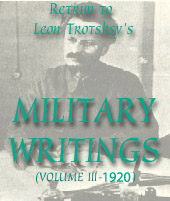
As is well known, the Makhnovites do not recognise the regulations of the Red Army and have created their own organisation, allegedly based on ‘free’ anarchist principles. It is of very great interest and importance for not only every Red Army man but also every worker and conscious peasant to learn what these ‘free’ anarchist principles look like in practice.
It is now possible for us to get to know them close up. The Revolutionary War Council of the Southern front despatched some responsible workers to the headquarters of Makhno’s troop, and, when they had familiarised themselves with the situation on the spot, they reported on it in detail to the Front Command. We extract the most important sections of this report.
In principle – that is, in words – organisation of Makhno’s troops is based on electivity of commanders, on volunteering by all the fighters, and on the strictest ‘self-discipline’. Let us examine these principles, one by one.
For his own protection Makhno has a ‘Black Squadron’ in which, as the Makhnovites put it, discipline is ‘diabolical’. Makhno’s quarters are guarded by a strong squad of between five and seven sentries. Strangers are not allowed to approach Makhno without being disarmed.
He has his own Cheka, called ‘Counter-Intelligence’.
The army possesses gold, diamonds and other jewels, valuable furs and other clothing, all this being, to a noticeable extent, mostly held by the commanders.
That is how the anarchist principles appear in practice. An army cannot, of course, be built upon principles of freedom and independence, for each and everyone, like, for example, a literary club. But it is quite obvious that in our regular Red Army there is incomparably more freedom and more respect for the Red Army man’s personality than prevails in Makhno’s ‘anarchist’ troop.
When, not long ago, in one of our armies a responsible and meritorious comrade, while in a state of extreme nervous excitement, struck a Red Army man, this worthy comrade, who held a post of responsibility, was at once relieved, taken away and punished. Meanwhile, in Makhno’s troop blows in the face are considered a means of ‘self-discipline’.
Every Red Army man must be made aware of the actual methods used in the Makhnovite organisation: he will then appreciate more highly the regime of our Red Army, which is increasingly filled with consciousness and the Communist spirit, and in which free devotion to duty is increasingly replacing compulsion and coercion.
1. The tachanka was a light, sprung cart drawn by two horses (used by Ukrainian peasants), on which Makhno mounted a machine-gun, with two men to work it, plus the driver. His extensive use of these tachanki gave Makhno a powerful combination of mobility with fire-power, and the device was copied by the Red Army. See Babel, Discourse on the Tachanka, in his Collected Stories (1955).

Last updated on: 27.12.2006